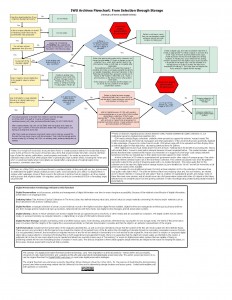This blog is reposted from one that originally appeared at http://drewvandecreek.blogspot.com/ on July 31, 2015.
This is funny.
In the course of preparing an article with my colleague Jaime Schumacher I came across Ross Harvey’s “So Where’s the Black Hole in our Collective Memory?: A Provocative Position Paper” (January, 2008), which suggests that the digital preservation community has been overly alarmist in contending that digital materials are succumbing to a variety of risk factors, rendering them unavailable for future use.
Harvey maintained that – at least in 2008 – researchers had not presented enough evidence to demonstrate that digital materials loss was taking place on a meaningful scale, and asked for further data. Our article provided such data, so I decided to include Harvey’s request in the text.
This meant that I needed to provide a citation for his paper, of course. I had previously found it available online via the Digital Preservation Europe web site at http://www.digitalpreservationeurope.eu/forum/phpBB2/, but on July 29, 2015 I could not find a copy of it online – at all. I tried again yesterday and today. No luck.
Just to be clear, I was unable to find a copy of a 2008 paper arguing that digital preservation advocates had overstated the threat of digital data loss, including that presented on the web. How ironic.
Remembering a certain pop singer’s misuse of the word “ironic” in a hit song some twenty years ago, I turned to the Oxford English Dictionary for a definition of “irony.”
I found, as the third meaning of the noun – “a state of affairs or an event that seems deliberately contrary to what was or might be expected; an outcome cruelly, humorously, or strangely at odds with assumptions or expectations.”
I would note that this occurrence certainly seems to contrary to Mr. Harvey’s expectations – at least from 2008, but it is not contrary to my own.
Our paper on digital data loss among university faculty will be published shortly by the International Journal of Digital Curation. It corroborates digital preservation advocates’ familiar contention that data loss is indeed taking place.
Feel free to mention our findings in presentations to campus stakeholders and conversations with individuals unaware of the threat of digital data loss.
You might also use the Ross Harvey story for an icebreaker or a laugh midway through a talk.
Ultimately I provided a citation for Harvey’s paper from the Internet Archive’s Wayback Machine, which seeks to address situations like this by providing access to an archive of web pages, organized chronologically. In effect, it seeks to provide snapshots of the web at given dates.
Mr. Harvey would certainly contend that his paper’s existence on the Wayback Machine proves his point – that digital data disappearing from its original place of online presentation can very often be retrieved elsewhere. And so it was.
The Wayback Machine is far from comprehensive, however. It is also little-known among those outside the library and information science community.
Harvey also may have retreated from his intentionally provocative 2008 proclamation. Even if he has, this situation creates a potentially useful anecdote in the ongoing effort to convince those outside the community of practitioners that the threat of digital data loss is real.








